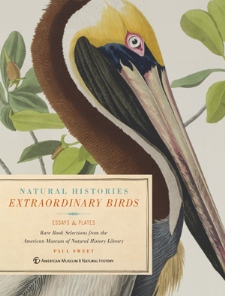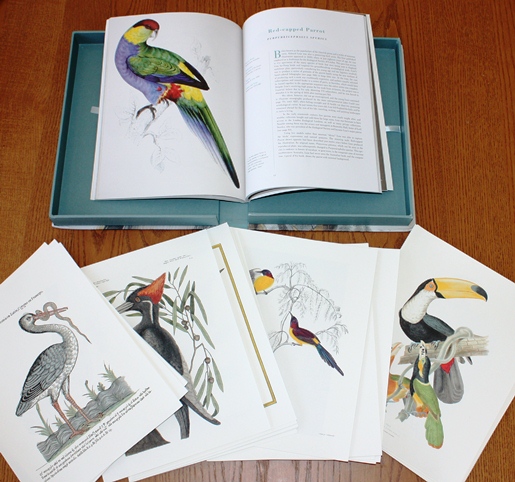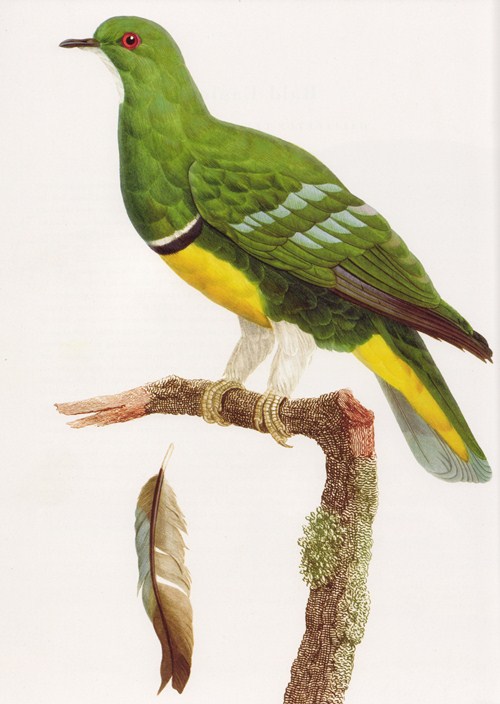Reviewed by Grant McCreary on January 18th, 2014.
One of the things I’ve always liked about bird books is the combination of informative text and beautiful illustrations. However, this isn’t a modern phenomenon; people have been producing lavishly illustrated bird books since before Guttenberg was born. Extraordinary Birds: Essays and Plates of Rare Book Selections from the American Museum of Natural History Library celebrates these books. In this collection, Paul Sweet, the ornithology collection manager at the American Museum of Natural History, gives us a peek at significant works from the museum’s Rare Book Collections, and through them traces the history of ornithology.
Extraordinary Birds includes both a book and 40 prints from historic ornithology books. These are housed in an attractive, cloth-covered clamshell case. The works selected for inclusion date back to 1555, when the first printed and illustrated monograph devoted solely to birds was published by Pierre Belon. The most recent is a 1930 portfolio of field sketches by Louis Agassiz Fuertes. But most of the books were published in the 19th Century, in what had to be the golden age of ornithology books. You’ll recognize many of the names, such as Alexander Wilson, John James Audubon, and John Gould. But I also enjoyed being introduced to other, quite impressive authors and artists.
The Book
This handsome paperback starts with an overview of birds and the science of ornithology. Taxonomy and bird physiology is described in surprisingly technical detail. This introduction to bird biology, especially one so detailed, seems out of place in a book such as this. I would be very surprised if many of this book’s target audience are interested in learning about the duodenum. Of more relevance is the discussion of the materials and methods of bird study, although some readers may wish to skip the graphic description of how study skins are prepared. Finally, there is a disappointingly short treatment of ornithology in print. Overall, this first part of the book misses the target with either too much or too little information given and with material that doesn’t seem relevant to the project as a whole.
Part II of the book fares much better. Each of the 40 prints in this set is also reproduced in the book, although often zoomed in so that the entire image isn’t visible. Accompanying each is an essay from Paul Sweet that gives information on the artist, the author of the book from which it was taken, and the species depicted. These essays are brief, most being a single page, but very interesting. The main focus is on the author and artist and their contributions to ornithology. Sweet also includes some, often tantalizingly brief, information on the artwork itself and how it was produced, along with the natural history of the bird.
A perfect example of how all of this comes together is found in the essay on the Cloven-feathered Dove.
Pauline Knip illustrated this plate for Coenraad Jacob Temminck’s monograph of pigeons, produced in the early 19th Century. Temminck, who would go on to become one of the world’s foremost ornithologists, established his reputation with this work. When searching for an artist to illustrate it, he met Pauline and she produced the plates for the first installment of his book. However, he later discovered that she had swindled him by producing subsequent installments under her name only. It’s possible she felt she could get away with it because she had become the official natural history painter to Napoleon’s wife.
However, as Sweet writes: “Despite her questionable ethics, Madame Knip’s reputation as one of the finest bird illustrators of her day remains unchallenged.” It’s easy to see why from looking at this plate – it’s gorgeous. The colors jump off the page, and Sweet clues us into why – Knip used a technique that applied colored inks directly onto the engraving plates, which produces more vibrant colors than the traditional method of hand-painting the printed images. Of the bird itself, Sweet mentions that it is named for its unique notched wing feathers (one of which is shown on the plate), and that it is endemic to the forests of New Caledonia in the southwest Pacific.
This mixture of the biographical, artistic, and natural history keeps the essays from becoming boring or repetitious. Due to space constraints, none of these topics can be covered in detail and many times I wished it could have gone into more depth. For instance, there’s no mention of why the Cloven-feathered Dove has such unique wing feathers. Do they make some kind of specialized sound? (A quick search elsewhere revealed the answer to that last question to be yes.)
Here are some more of the interesting things I learned in Extraordinary Birds:
- The artwork in John Gould’s monograph of the hummingbirds is “notable for the iridescence given to the plumages by the application of gold leaf, transparent oil colors, lacquers, and gum arabic” (I’d love to see one of these originals!)
- The Crimson Topaz, a beautiful hummingbird, forages on flowers high in the canopy. So the composition of the plate included here, where the birds are seemingly at ground level, is “pure fantasy”.
- French ornithologist Jean-Théodore Descourtilz, who was also interested in botany, is believed to have “become ill after trying the berries of a particular tree favored by birds but poisonous to humans”.
The Art Prints
The art, just as much as the text, is a revelation. Of the birds depicted, many – like the Bald Eagle, Ivory-billed Woodpecker, and Blue Tit – are familiar. But others even some long-time birders may not have heard of, such as the Scimitar-billed Woodcreeper (great name!). And while artistically they range from basic (especially the earlier pieces) to breathtaking, they are all interesting.
These prints, however, are somewhat disappointing. They seem a little soft to me, like they are slightly out of focus. Additionally, the colors are not nearly as vivid as they are in the book. Still, these prints wouldn’t look out of place framed and hung. They are all 8.5 x 11 inches in size.
Recommendation
If you’re interested in ornithological history, books, and/or art, then you should enjoy Extraordinary Birds: Essays and Plates of Rare Book Selections from the American Museum of Natural History Library. It’s not a perfect set, but an interesting book plus 40 prints for $50 (or less) is a great deal.
Note: Barnes & Noble offers an exclusive edition of this set that contains five extra prints. And it’s only $25 at the time of this post!
Disclosure: I get a small commission for purchases made through links in this post.
Buy from NHBS
(based in the U.K.)
Disclosure: The item reviewed here was a complementary review copy provided by the publisher. But the opinion expressed here is my own, it has not been influenced in any way.








Comment